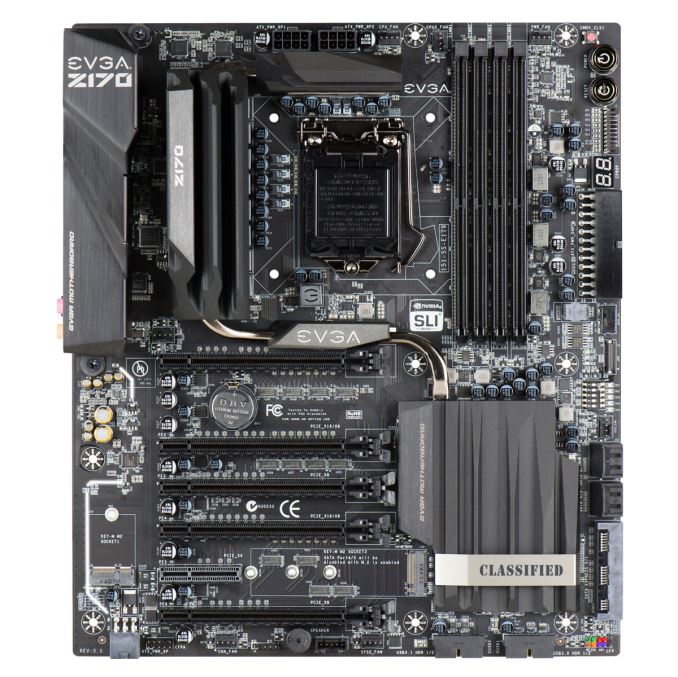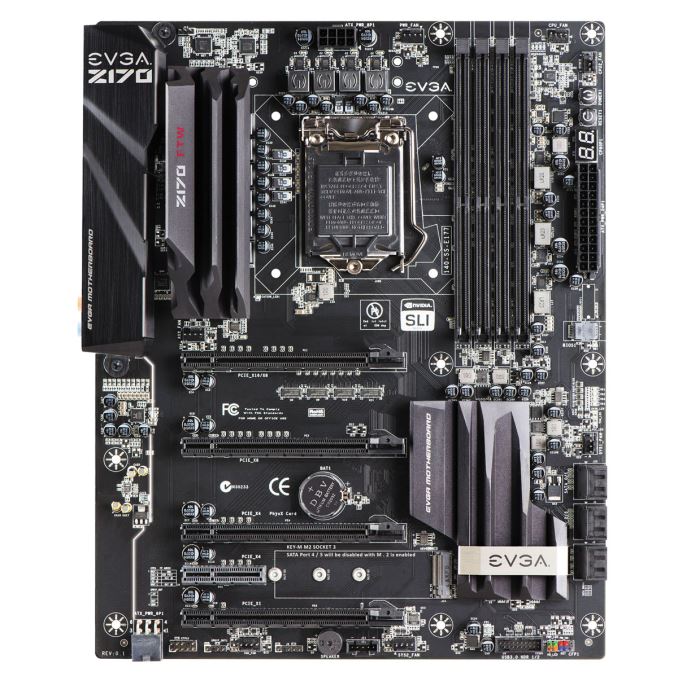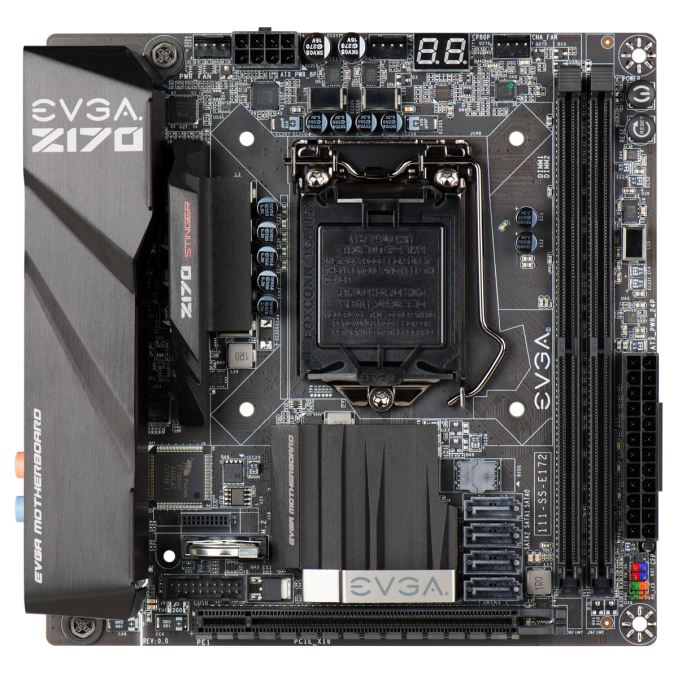Intel Skylake Z170 Motherboards: A Quick Look at 55+ New Products
by Ian Cutress on August 5, 2015 7:59 AM ESTEVGA Z170
Over the past few generations of EVGA motherboards, one of the goals has been to emulate the success they achieved during the X58 motherboard era. At that time, the motherboards were highly praised for their overclocking prowess for what was (and still is) a relatively small motherboard manufacturer. EVGA’s historic strengths lie in their legions of fans and a typical expectation that in most of their big markets, they will field the warranty issues rather than the retailer. Z170, like the others, brings on the EVGA wind in the three regular segments.
EVGA Z170 Classified
Aimed at the pure high end, the EVGA Classified might be the most expensive Z170 board on the market. Here they have used a single PLX 8747 chip under that middle heatsink to provide x8/x8/x8/x8 bandwidth to the PCIe slots. Using a PLX 8747 chip on a mid-range motherboard is not new, it was all the rage back in Z77, but what makes it different here is that the company that manufactures the chip has changed hands and now focuses on the enterprise market. As a result, the costs of such a chip are seemingly doubled overnight, making it an unenticing prospect for the consumer market. Nonetheless, EVGA is aiming for an overclocking motherboard with Quad-SLI support and here it is.
Alongside the extensive heatsink configuration to aid both the power delivery and that PLX chip, EVGA equips the board with dual network controllers (I219-V and I210-AT), a Creative Sound Core3D audio solution, two USB 3.1-A ports on the rear panel, an M.2 slot running in PCIe 3.0 x4 mode, seven 4-pin PWM fan headers, triple BIOS support, EZ voltage read points and the onboard readout will output the temperature when in the operating system.
EVGA Z170 FTW
The FTW follows a similar design pattern to the classified in terms of hardware layout, but reduces it all down into a more cost effective market. As a result the PLX chip is gone, the power delivery heatsink arrangement is reduced, a number of the OC features are lifted off and other connectivity is reduced. The single network port is an Intel I219-V, there is no USB 3.1 and we have the base six SATA ports from the chipset. We still keep the M.2 based off of the PCIe 3.0 x4 bandwidth, but the PCIe slots only support up to x8/x4/x4 with the final slot being an x1. This seems a little odd, given how many PICe lanes the chipset can use.
EVGA Z170 Stinger
The Stinger is the mini-ITX solution, keeping the line alive after several generations. Taking on board previous comments, the power connectors are now on the outside of the DRAM slots or at the top of the motherboard, along with the important front panel connectors. There seems to be enough space around the CPU slot for larger air coolers, although the SATA connector placement will be a nightmare when locking cables and large PCIe cards are used. EVGA does list the Stinger as having a 10-layer PCB, which might make it one of the mini-ITX motherboards with the most layers, although this just makes the design of the board easier and pushes up cost. Similar to the FTW, we don’t get USB 3.1 on this model with only an Intel I219-V network port and Realtek audio.













85 Comments
View All Comments
Oyster - Wednesday, August 5, 2015 - link
Ian, do you think it is possible to supply us with a tabular breakdown of all the motherboards? Not sure about others, but going through page-by-page is a bit overwhelming, and confusing at the very least. Good coverage as usual!Eidigean - Wednesday, August 5, 2015 - link
I second this. looking for number of M.2 slots, PCIe slots, USB 3.1 ports w/ type of controller (Alpine or otherwise). I'm shocked so few support 3 M.2 slots.MrBowmore - Wednesday, August 5, 2015 - link
Why not just use the pcie? Is there anything better than a intel 750 and demands M.2? I dont get the need for M.2.Eidigean - Wednesday, August 5, 2015 - link
Well, the SM951 is quite interesting. Also, if the M.2 slots are used, the PCIe slots can be used for 4 GPUs, NICs, or RAID cards. The ASUS workstation board in this article is interesting.Gadgety - Wednesday, August 5, 2015 - link
Tabular would be great.The_Assimilator - Wednesday, August 5, 2015 - link
Z170X-UD5 and Z170X-UD3 galleries are swapped.I'm glad to see that Gigabyte is exposing 2x USB 3.0 internal headers on almost all their boards - USB 2.0 needs to die. Now if only they would replace the dual USB 2.0 headers with an additional 3.0, giving 3x USB 3.0 headers, then I would be ecstatic. My Z77X-UD5H is still the only decently-priced motherboard around with a trio of USB 3.0 headers, and it's not getting any newer!
Regardless, I'm probably going to skip Skylake, for the simple reason that I'm not interested in buying a board equipped with the useless SATA Express. By the time Cannonlake rolls around, M.2/NGFF should have killed SATAe and there will be even more USB 3.0 ports from the chipset.
DanNeely - Wednesday, August 5, 2015 - link
I bought a GB board for a 4790k earlier this year for the dual headers. At least in the medium term though, I think they do need to keep 1 or 2 2.0 headers around. Not everyone buys a new case for their new builds, and older cases have built in 2.0 ports on the front/top panel. The same thing for front panel SD card readers; there are USB 3.0 versions out now, but the SD reader won't benefit from the faster connection so why spend money to replace it. I can't remember who makes it, but there's one OEM who sells some PSUs with an internal USB2 header for monitoring purposes.Beyond all of that, the chipset itself provides 14USB ports only 10 of which can be 3; so the mobo makers have 2 "free" headers to do something with. Dell/HP/etc will ignore them; but in the box ticking consumer market they're going to get used either for internal headers or a pairs of ports in the back. Anyone clinging to w7 who doesn't have PS2 peripherals in the closet will need those since 7 doesn't have a USB3 class driver; and at least in my case refused to talk to a 2.0 device in a 3.0 port until I got drivers installed.
Impulses - Thursday, August 6, 2015 - link
If you're using an SD reader for a modern camera with modern SD cards then it'll absolutely benefit from USB 3.0... Last 128GB SD I bought for like $58 can read at 150MB/s (or about 3x USB 2.0 speeds), Lexar UHS-II card. Most recent mirrorless bodies can take advantage of it too...8steve8 - Wednesday, August 5, 2015 - link
when will these actually be for sale?Ian Cutress - Wednesday, August 5, 2015 - link
Depends on the motherboard and what region you are in, but some are listed already: http://www.amazon.com/s/ref=nb_sb_noss?url=search-...